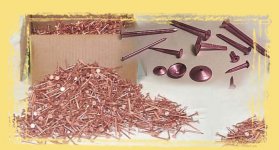jeremiah212
Full Member
i detected the yard of an old home(150yrs) ....in 2 hours i found 1 quarter one penny and about 60 of these odd looking thingamagiggers..they where everywhere. so many i got mad an went to another site instead
can't figure what there for..anyone seen them befor?


all of em look exactly the same with the same bend.
can't figure what there for..anyone seen them befor?


all of em look exactly the same with the same bend.











